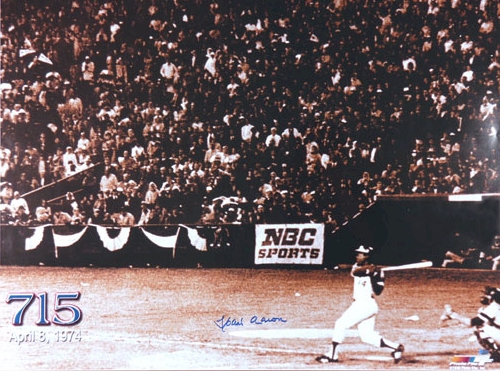As I was reading the coverage of Barry Bonds surpassing Hank Aaron as Major League Baseball‘s Home Run King, it became to me that there was not one single defining photograph of him that captured his historic achievement. From our two local papers here in the Twin Cities, the Star Tribune and the Pioneer Press, to Major League Baseball, ESPN, Fox Sports, Sports Illustrated, and The Sporting News, they all used a variety of photos of Bonds to illustrate the story. Check out the Newseum’s Today’s Papers section and you’ll find the same.
When I think of Hank Aaron surpassing Babe Ruth as the career home runs leader with his 715th bomb, I think of one image and one image only:
Since the invention of photography, every era in our history has had certain iconic images associated with it that helped define, in a glance, that era. The same holds true for many of our most significant historic events or moments.
The slide show below features iconic photographs from our nation’s history
Flickr Slide Show Of Iconic Photography
(See below for links to full-sized photos)
As I was scrolling through Barry Bonds Flickr photos today, it occurred to me that Flickr has pounded the last nail in iconography’s coffin. The Flickr Effect obliterates mass appeal through the volume and the dissolution of attention its RSS distribution system enables.
From here on out, I think it will be rare that a single image will become iconic by defining an event or era.
The environment for icons was much more friendly when we had three television networks, a couple of national newspapers, and a handful of
weekly news magazines.
The death of iconic images has been coming for some time. It started with the expansion of news media outlets by the introduction of cable television and it continued when the avenues through which people consumed news expanded dramatically with the popularity of the Web. But it exploded with the rise of blogs, low cost digital cameras, citizen journalism, and the distribution platforms of Flickr and other photo sharing sites.
Mass media is dead. Because we get our news through such a vast array of sources, it is virtually impossible for one news organization to capture a large enough percentage of public for an iconic image to emerge.
It is certainly possible for an image to gain enough popular appeal to become an icon; it’s just not likely.
Take 9/11. Surely the burning of the Twin Towers of the World Trade Center was an iconic image. Everyone can close their eyes and see that image in their mind’s eye. But there is not one single photograph that is the icon. There was so much coverage from so many different sources that the photographic library of the attack was too voluminous, photos of the buildings were taken from so many different angles, that no single image ever had a chance to emerge as an icon.
The death of the icon is due to too much. Too much volume and too many sources.
Links to the Full-Size Photos Featured in the Slide Show:
The first photo is, of course, Abraham Lincoln, the iconic figure of the Civil War era. The Jesse James Gang and other outlaw photographs are emblematic of the post Civil War Wild West era. Wilbur and Orville Wright‘s
first flight represent the 1900s. The Roaring Twenties and Jazz Age
are captured by the famous photo of jazz singer Josephine Baker. The
photo of a migrant mother captures the Great Depression of the 1930s in
all its anguish, desperation, and poverty. The Hindenburg disaster
marked one of the most indelible word wide media events of the modern age. A photo of a lynching captures a national
sin. The St. Valentines Day Massacre dramatically illustrates the gangsterism of the
prohibition era. In the 1940s, we fought and won World War II and we
re-elected a president, though some were not quite sure. The 1950s are
captured by Marilyn Monroe holding down her skirt in The Seven Year
Itch. The turbulence of the sixties included the assassination of a
president, controversy, sorrow, a new president, the struggle for civil
rights, cultural change, the conquering of space, and a long and
unpopular war. The student pro-democracy protesters in China’s Tiananmen Square marked a turning point in world history. The famine in Sudan was dramatically illustrated by a vulture hovering over a dying child.
See also:
The e-Strategy Academy covers all aspects of digital marketing including search optimization & marketing, email marketing, social media marketing, video marketing, mobile marketing & public relations.
